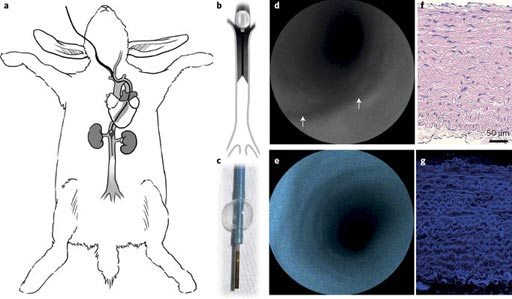Laser-Based Angioscope Improves Carotid Artery Scanning
By MedImaging International staff writers
Posted on 23 Feb 2017
A novel scanning fiber endoscope (SFE) acquires high-quality images of atherosclerotic lesions in the carotid artery that may not be detected with conventional radiological techniques.Posted on 23 Feb 2017
Developed by researchers at the University of Michigan and the University of Washington, the SFE system consists of an ultrathin, highly flexible catheter that scans blue, green, and red laser beams in a spiral pattern on the tissue surface, collecting reflectance and fluorescence images through a ring of optical fibers. The multimodal images are then reconstructed in real time with a large field of view (FOV) and projected with high spatial resolution.

Image: A high-definition multimodal SFE of the carotid artery (Photo courtesy of U-M).
By combining reflectance and laser-induced emission of intrinsic fluorescent constituents in vascular tissue, the SFE generates endoscopic videos capable of discriminating early, intermediate, advanced, and complicated atherosclerotic plaques. In addition, by targeting proteolytic activity of complicated atherosclerotic plaques with a fluorescence agent activated by matrix metalloproteinases (MMPs), vulnerable regions of the weakened fibrous cap can be detected at a resolution far beyond clinically available technology.
According to the researchers, the superior image resolution of the technology reveals intravascular thrombi and surface thrombogenic lesions, even in cases not detected by conventional diagnostic modalities, and claim that multimodal laser-based SFE angioscopy has the potential to become a powerful platform for research, diagnosis, prognosis, and image-guided local therapy in atherosclerosis and cardiovascular disease. The study was published on February 10, 2017, in Nature Biomedical Engineering.
“The camera actually goes inside the vessels. We can see with very high resolution the surface of the vessels and any lesions, such as a ruptured plaque, that could cause a stroke,” said lead author neurosurgeon Luis Savastano, MD, of U-M. “This technology could possibly find the 'smoking gun' lesion in patients with strokes of unknown cause, and may even be able to show which silent, but at-risk, plaques may cause a cardiovascular event in the future.”
“The ability to identify and monitor the biological markers that render a plaque unstable and at risk for rupture could enable the detection of individuals within high-risk populations who are most likely to suffer from cardiovascular events, and therefore benefit the most from preventive treatment during the asymptomatic stage,” said senior author Professor Gregory Thompson, MD, of U-M. “In addition, plaque-specific data could help physicians modulate treatment intensity of atherosclerosis, which is currently based on systemic surrogates such us cholesterol and blood sugar levels and occurrence of cardiovascular events such as stroke or myocardial infarction.”














